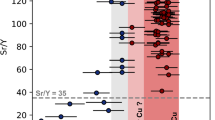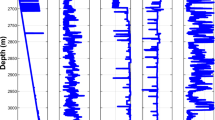Abstract
This paper describes a new method based on the particle swarm optimisation (PSO) technique for interpreting the second moving average (SMA) residual gravity anomalies. The SMA anomalies are deduced from the measured gravity data to eradicate the regional anomaly by utilising filters of consecutive window lengths (s-value). The buried structural parameters are the amplitude factor (A), depth (z), location (d) and shape (q) that are estimated from the PSO method. The discrepancy between the measured and the predictable gravity anomaly is estimated by the root mean square error. The PSO method is applied to two different theoretical and three real data sets from Cuba, Canada and India. The model parameters inferred from the method developed here are compared with the available geological and geophysical information.












Similar content being viewed by others
References
Abdelrahman E M and Essa K S 2013 A new approach to semi-infinite thin slab depth determination from second moving average residual gravity anomalies; Explor. Geophys. 44 185–191.
Abdelrahman E M and Essa K S 2015 Three least-squares minimization approaches to interpret gravity data due to dipping faults; Pure Appl. Geophys. 172 427–438.
Abdelrahman E M, El-Araby T M and Essa K S 2003 Shape and depth solutions from third moving average residual gravity anomalies using the window curves method; Kuwait J. Sci. Eng. 30 95–108.
Abdelrahman E M, Abo-Ezz E R, Essa K S, El-Araby T M and Soliman K S 2006 A least-squares variance analysis method for shape and depth estimation from gravity data; J. Geophys. Eng. 3 143–153.
Abdelrahman E M, Essa K S and Abo-Ezz E R 2013 A least-squares window curves method to interpret gravity data due to dipping faults; J. Geophys. Eng. 10 025003.
Al-Garni M A 2008 Walsh transforms for depth determination of a finite vertical cylinder from its residual gravity anomaly; SAGEEP 6–10 689–702.
Amjadi A and Naji J 2013 Application of genetic algorithm optimization and least square method for depth determination from residual gravity anomalies; J. Sci., Eng. Technol. 11 114–123.
Asfahani J and Tlas M 2012 Fair function minimization for direct interpretation of residual gravity anomaly profiles due to spheres and cylinders; Pure Appl. Geophys. 169 157–165.
Asfahani J and Tlas M 2015 Estimation of gravity parameters related to simple geometrical structures by developing an approach based on deconvolution and linear optimization techniques; Pure Appl. Geophys. 172 2891–2899.
Babu L A, Reddy K G and Mohan N L 1991 Gravity interpretation of vertical line element and slap – A Mellin transform method; Indian J. Pure Appl. Math. 22 439–447.
Biswas A 2015 Interpretation of residual gravity anomaly caused by a simple shaped body using very fast simulated annealing global optimization; Geosci. Front. 6 875–893.
Biswas A 2016 Interpretation of gravity and magnetic anomaly over thin sheet-type structure using very fast simulated annealing global optimization technique; Model Earth Syst. Environ. 2 30.
Biswas A 2017 A review on modeling, inversion and interpretation of self-potential in mineral exploration and tracing paleo-shear zones; Ore Geol. Rev. 91 21–56.
Chai Y and Hinze W J 1988 Gravity inversion of an interface above which the density contrast varies exponentially with depth; Geophysics 53 837–845.
Davis W E, Jackson W H and Richter D H 1957 Gravity prospecting for chromite deposits in Camaguey province, Cuba; Geophysics 22 848–869.
Eberhart R C and Kennedy J 1995 A new optimizer using particle swarm theory; In: Proceedings of the IEEE – The sixth symposium on Micro Machine and Human Centre, Nagoya, Japan, pp. 39–43.
Ekinci Y L and Yiğitbaş E 2015 Interpretation of gravity anomalies to delineate some structural features of Biga and Gelibolu peninsulas, and their surroundings (north-west Turkey); Geodin. Acta 27 300–319.
Ekinci Y L, Ertekin C and Yiğitbaş E 2013 On The effectiveness of directional derivative based filters on gravity anomalies for source edge approximation: Synthetic simulations and a case study from the Aegean Graben System (Western Anatolia, Turkey); J. Geophys. Eng. 10 035005.
Ekinci Y L, Balkaya C, Göktürkler G and Turan S 2016 Model parameter estimations from residual gravity anomalies due to simple-shaped sources using differential evolution algorithm; J. Appl. Geophys. 129 133–147.
Essa K S 2007a A simple formula for shape and depth determination from residual gravity anomalies; Acta Geophys. 55 182–190.
Essa K S 2007b Gravity data interpretation using the s-curves method; J. Geophys. Eng. 4 204–213.
Essa K S 2011 A new algorithm for gravity or self-potential data interpretation; J. Geophys. Eng. 8 434–446.
Essa K S 2012 A fast least-squares method for inverse modeling of gravity anomaly profiles due simple geometric-shaped structures; In: Near surface geoscience, 18th European meeting of environmental and engineering geophysics, Paris, France.
Essa K S 2013 Gravity interpretation of dipping faults using the variance analysis method; J. Geophys. Eng. 10 015003.
Essa K S 2014 New fast least-squares algorithm for estimating the best-fitting parameters of some geometric-structures to measured gravity anomalies; J. Adv. Res. 5 57–65.
Essa K S and Elhussein M 2018a PSO (particle swarm optimization) for interpretation of magnetic anomalies caused by simple geometrical structures; Pure Appl. Geophys. 175 3539–3553.
Essa K S and Elhussein M 2018b Gravity data interpretation using new algorithms: A comparative study; In: Gravity-geoscience applications (ed.) Zouaghi Z, Industrial Technology and Quantum Aspect, InTech, Croatia, 226p.
Essa K S, Nady A G, Mostafa M S and Elhussein M 2018 Implementation of potential field data to depict the structural lineaments of the Sinai Peninsula, Egypt; J. Afr. Earth Sci. 147 43–53.
Grant F S and West G F 1965 Interpretation theory in applied geophysics; McGraw-Hill Book Company, New York, 583p.
Griffin W R 1949 Residual gravity in theory and practice; Geophysics 14 39–58.
Gupta O P 1983 A least-squares approach to depth determination from gravity data; Geophysics 48 360–375.
Hajihassani M, Jahed Armaghani D and Kalatehjari R 2018 Applications of particle swarm optimization in geotechnical engineering: A comprehensive review; Geotech. Geol. Eng. 36 705–722.
He Q and Wang L 2007 An effective co-evolutionary particle swarm optimization for constrained engineering design problems; Eng. Appl. Artif. Intell. 20 89–99.
Hinze W J, von Frese R R B and Saad A H 2013 Gravity and magnetic exploration: Principles, practices and applications; Cambridge University Press, UK, 512p.
Jordehi A R 2018 Enhanced leader particle swarm optimisation (ELPSO): An efficient algorithm for parameter estimation of photovoltaic (PV) cells and modules; Sol. Energy 159 78–87.
Kawada Y and Kasaya T 2018 Self-potential mapping using an autonomous underwater vehicle for the Sunrise deposit, Izu-Ogasawara arc, southern Japan; Earth Planet. Space 70 142.
Kilty K T 1983 Werner deconvolution of profile potential field data; Geophysics 48 234–237.
Luu K, Noble M, Gesret A, Belayouni N and Roux P 2018 A parallel competitive particle swarm optimization for non-linear first arrival travel-time tomography and uncertainty quantification; Comput. Geosci. 113 81–93.
Mehanee S A 2014 Accurate and efficient regularised inversion approach for the isolated gravity anomalies; Pure Appl. Geophys. 171 1897–1937.
Mehanee S A 2015 Tracing of paleo-shear zones by self-potential data inversion: Case studies from the KTB, Rittsteig, and Grossensees graphite-bearing fault planes; Earth Planet. Space 67 14–47.
Mehanee S A and Essa K S 2015 2.5D regularized inversion for the interpretation of residual gravity data by a dipping thin sheet: Numerical examples and case studies with an insight on sensitivity and non-uniqueness; Earth Planet. Space 67 130.
Nishijma J and Naritomi J 2017 Interpretation of gravity data to delineate underground structure in the Beppu geothermal field, central Kyushu, Japan, regional studies; J. Hydrol. 11 84–95.
Osman O, Albora A M and Ucan O N 2006 A new approach for residual gravity anomaly profile interpretations: Forced neural network (FNN); Ann. Geophys. 49 1201–1208.
Pawlowski R S 1994 Green’s equivalent-layer concept in gravity bandpass filter design; Geophysics 59 69–76.
Rao P, Subrahmanyan M and Murthy S 1986 Nomograms for direct interpretation of magnetic anomalies due to long horizontal cylinders; Geophysics 51 2150–2159.
Reddi A G B, Murthy B S R and Kesavanani M A 1995 Compendium of four decades of geophysical activity in geological survey of India; GSI Special Publication No. 36, Geological Survey of India.
Roshan R and Singh U K 2017 Inversion of residual gravity anomalies using tuned PSO; Geosci. Instrum. Method Data Syst. 6 71–79.
Roy L 2001 Short note: Source geometry identification by simultaneous use of structural index and shape factor; Geophys. Prospect. 49 159–164.
Roy L, Agarwal B N P and Shaw R K 2000 A new concept in Euler deconvolution of isolated gravity anomalies; Geophys. Prospect. 48 559–575.
Santilano A, Godio A and Manzella A 2018 Particle swarm optimization for simultaneous analysis of magnetotelluric and time-domain electromagnetic data; Geophysics 83 E151–E159.
Singh A and Biswas A 2016 Application of global particle swarm optimization for inversion of residual gravity anomalies over geological bodies with idealized geometries; Nat. Resour. Res. 25 297–314.
Stavrev P Y 1997 Euler deconvolution using differential similarity transformations of gravity or magnetic anomalies; Geophys. Prospect. 45 207–246.
Sundararajan N and Rama Brahmam G 1998 Spectral analysis of gravity anomalies caused by slab-like structures: A Hartley transform technique; J. Appl. Geophys. 39 53–61.
Wang Y, Lv J, Zhu L and Ma Y 2010 Crystal structure prediction via particle-swarm optimization; Phys. Rev. B82 094116.
Zhang J, Zhong B, Zhou X and Dai Y 2001 Gravity anomalies of 2D bodies with variable density contrast; Geophysics 66 809–813.
Acknowledgements
The authors would like to thank Prof N V Chalapathi Rao, Editor-in-Chief, Prof Arkoprovo Biswas, Associate Editor, and the two anonymous expert reviewers for their keen interest and constructive comments for improving our original manuscript. The first author wishes to thank the Science and Technology Development Fund (STDF) and the Institut Francais d’Egypte (IFE) for providing full support to the completion of this work.
Author information
Authors and Affiliations
Corresponding author
Additional information
Corresponding editor: Arkoprovo Biswas
Rights and permissions
About this article
Cite this article
Essa, K.S., Munschy, M. Gravity data interpretation using the particle swarm optimisation method with application to mineral exploration. J Earth Syst Sci 128, 123 (2019). https://doi.org/10.1007/s12040-019-1143-4
Received:
Revised:
Accepted:
Published:
DOI: https://doi.org/10.1007/s12040-019-1143-4




